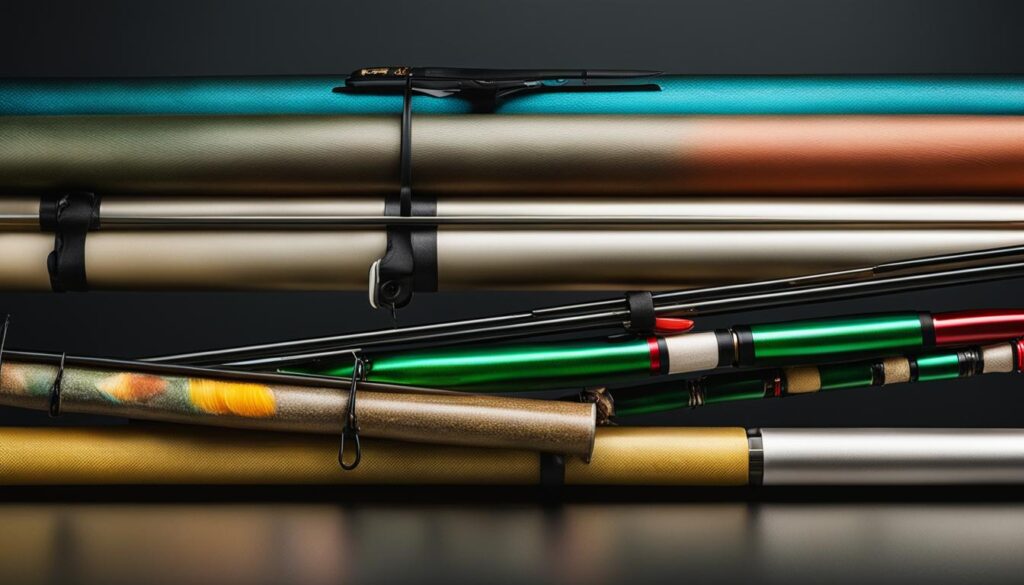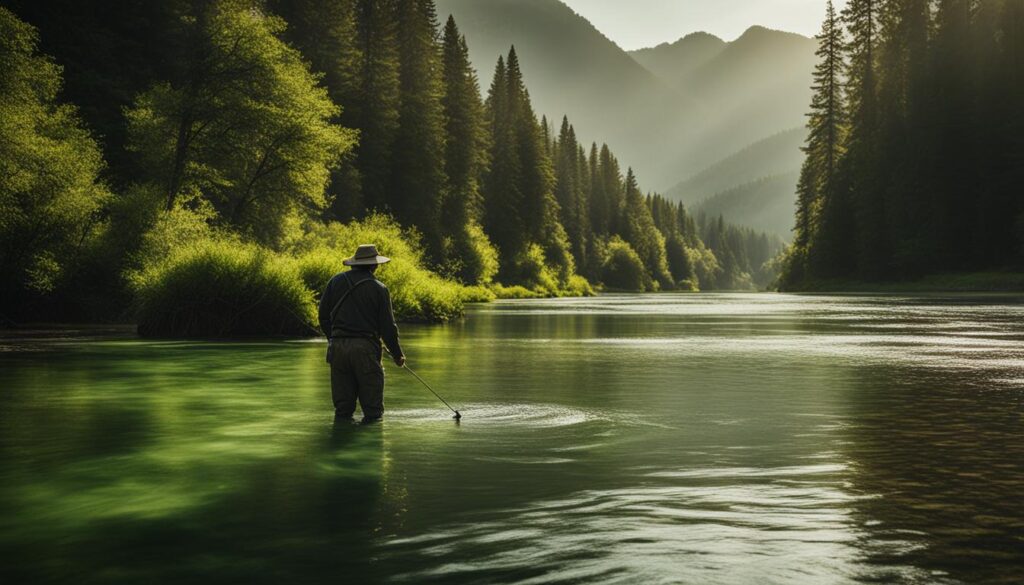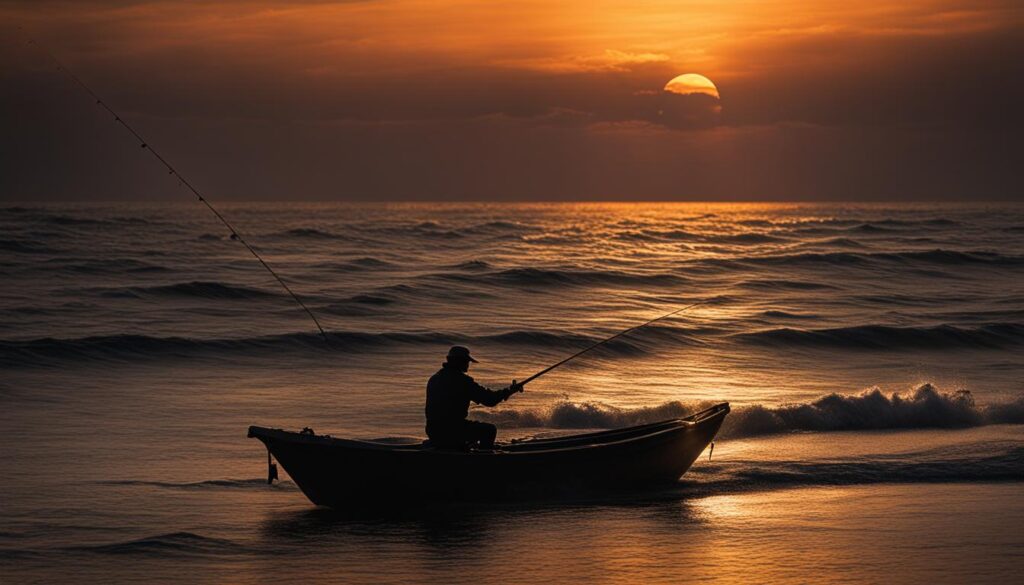We may earn money or products from the companies mentioned in this post.
Choosing the right bait and lure is a crucial aspect of successful fishing. Whether you’re a seasoned angler or a novice, understanding the factors that influence bait and lure selection can enhance your fishing experience and increase your chances of catching your desired fish.
In this section, we’ll provide expert tips on selecting the right bait and lure for maximum effectiveness. We’ll explore the benefits of fishing with artificial lures, techniques for selecting fishing bait, and choosing the right fishing lure to suit different scenarios.
Key Takeaways:
- Choosing the right bait and lure is essential for successful fishing.
- Understanding the factors that influence bait and lure selection can enhance your fishing experience.
- Fishing with artificial lures is a versatile and effective option.
- Techniques for selecting fishing bait and choosing the right fishing lure are crucial.
- Selecting the perfect bait can make all the difference in the world when it comes to catching your desired fish.
Factors to Consider When Selecting Bait and Lures
Before you head out on your next fishing trip, it’s crucial to consider the best bait options for fishing and popular lure types for different scenarios. Here are some factors to keep in mind when selecting bait and lures:
Bait Options
When it comes to selecting bait, consider the species of fish you are targeting. Some popular bait options include:
- Worms: A great all-purpose bait that is effective for catching a variety of fish species.
- Crawfish: Ideal for freshwater fishing, especially for bass and catfish.
- Crickets: A favorite among panfish anglers.
- Minnows: A versatile bait that can be used for both freshwater and saltwater fishing.
Lure Types
While live bait can be effective, artificial lures offer more versatility and can be used in various fishing scenarios. Here are some popular lure types to consider:
- Spinnerbaits: Ideal for catching bass, spinnerbaits are versatile and can be used in a variety of fishing scenarios.
- Crankbaits: An effective choice for catching game fish such as trout, walleye, and bass.
- Jigs: A versatile lure that can be used in both freshwater and saltwater fishing for a variety of game fish.
- Topwater lures: Effective for catching surface-feeding fish such as bass and musky.
The Fishing Lure Selection Guide
Not sure which bait or lure to use? Check out our fishing lure selection guide below:
| Species | Bait | Lure |
|---|---|---|
| Bass | Worms, minnows, crayfish | Spinnerbaits, crankbaits, jigs |
| Trout | Nightcrawlers, minnows, salmon eggs | Spinners, spoons, jigs |
| Walleye | Crawfish, minnows, leeches | Crankbaits, jigs, spinners |
| Panfish | Crickets, worms, grubs | Spinners, jigs, poppers |
Remember, the best bait and lure options for fishing depend on various factors, including the species of fish you are targeting, the time of day, and the water temperature. So, be sure to experiment with different options to find what works best for you.
Choosing Bait for Different Species of Fish
When it comes to selecting the right bait, one size does not fit all. Different species of fish have varying preferences, and as an angler, it’s important to equip yourself with the appropriate bait and lure recommendations to attract your desired catch effectively.
Bait and Lure Recommendations
Before we delve into specific bait options, here are a few general bait and lure recommendations to consider:
- Use fresh bait whenever possible. Fish are more likely to be attracted to fresh bait than stale, old bait.
- Consider the color of your bait or lure. The color should match the surrounding environment. For example, use bright colors in clear water and dark colors in murky water.
- Match your bait or lure to the size of the fish you’re targeting. A small bait will not attract a large fish, and a large bait will not attract a small fish.
Selecting Fishing Bait
Here are some popular bait options and tips for selecting the right one:
| Bait Type | Target Fish Species | Tips for Selecting |
|---|---|---|
| Worms | Trout, Bluegill, Catfish, Bass | Use nightcrawlers for larger fish and red worms for smaller fish. Thread the worm on the hook so it appears natural. |
| Minnows | Bass, Pike, Walleye, Perch | Use live minnows for best results. Hook the minnow through the lips or behind the dorsal fin. |
| Crayfish | Bass | Use a crayfish that matches the color of the surrounding environment. Hook the crayfish through the tail or between the eyes. |
Effective Bait and Lure Choices
Here are some additional effective bait and lure choices for various fish species:
- Salmon: Egg sacs, shrimp, smelt
- Trout: PowerBait, salmon eggs, small spinners
- Bass: Jigs, plastic worms, crankbaits
- Crappie: Minnows, jigs, small spinners
- Catfish: Chicken liver, prepared baits, nightcrawlers
Whether you’re fishing for trout or catfish, selecting the right bait is crucial. By considering bait and lure recommendations, using fresh bait, and matching your bait or lure to the surrounding environment, you can increase your chances of a successful and rewarding fishing experience.
Exploring Artificial Lure Options
Artificial lures are a popular choice for many anglers due to their versatility and effectiveness. They mimic the look and movement of various types of prey, making them highly attractive to different species of fish. When selecting artificial lures, there are a variety of options to consider, including:
- Soft plastic lures: These lures come in a variety of shapes and sizes, mimicking different types of prey. They are often used for bass fishing and can be rigged in different ways for different swimming actions.
- Hard baits: These lures are typically made of wood or plastic and include crankbaits, jerkbaits, and topwater baits. They are effective for imitating different types of baitfish and can be used for a variety of species.
- Spinnerbaits: These lures have a wire frame with one or more spinner blades and a skirt, which create vibration and movement in the water. They are often used for bass fishing in murky waters.
- Jigs: These lures consist of a hook with a weighted head and a skirt, which mimics the movement of prey in the water. They are versatile and can be used for a variety of species.
When choosing artificial lures, it’s important to consider the conditions you’ll be fishing in and the type of fish you’re targeting. For example, if you’re fishing in clear water, natural-looking lures may be more effective, while brighter lures may work better in murky water. Additionally, different species of fish may have different preferences for lures, so it’s important to do your research and choose the right option for your target catch.
Expert Tip: When using artificial lures, it’s important to vary your retrieval technique to mimic the natural movement of prey. This can include pausing your retrieve, changing the speed, or adding jerking or twitching movements.
Tips for Using Live Bait
Live bait can be a highly effective way to attract fish. When selecting your live bait, it’s important to consider the type of fish you’re targeting, the environment you’ll be fishing in, and the time of day. Here are some recommendations for selecting the right live bait:
- Worms: Commonly used for freshwater fishing, worms are a versatile live bait that can attract a variety of fish species. Earthworms, red wigglers, and nightcrawlers are all popular options.
- Minnows: Small fish like shiners, chubs, and minnows can be a great choice for freshwater and saltwater fishing. They are particularly effective for attracting predatory fish like bass, pike, and trout.
- Crawfish: These crustaceans can be an excellent choice for freshwater fishing, especially when targeting catfish or bass. They are particularly effective in rocky or weedy areas.
Once you’ve selected your live bait, it’s important to use it effectively to attract fish. Here are some tips:
- Keep your bait alive and healthy. It’s important to keep your live bait in a cool, aerated container to maintain its health and vitality.
- Select the appropriate hook size for your bait. The hook should be large enough to secure the bait without damaging it.
- Determine the appropriate depth to fish. You may need to experiment to find the right depth for your live bait, but a good rule of thumb is to start shallow and gradually move deeper until you find success.
- Use natural movements. Liv e bait should be presented in a natural way, mimicking the movements of its natural environment. Avoid using too much bait and keep it moving subtly to maintain its appeal.
Using live bait can be an effective way to attract fish, but it’s important to select the right type of bait and use it effectively. By following these tips, you can increase your chances of success on your next fishing trip.
Specialized Techniques for Bait and Lure Fishing
When it comes to fishing, it’s not just about selecting the right bait or lure – it’s also about employing the right techniques to attract your desired catch. In this section, we’ll explore some specialized techniques for bait and lure fishing that can help you improve your chances of success.
Retrieval Methods
One of the most important techniques to master as an angler is the retrieval method. The way you retrieve your bait or lure can make all the difference in attracting fish to your line.
For artificial lures, one effective technique is to use a “stop-and-go” approach. Cast your lure out and let it sink to the desired depth, then pause for a few seconds before reeling it in with short, jerky motions. This mimics the movement of a wounded baitfish and can be particularly effective for game fish like bass.
When using live bait, it’s important to adjust your retrieval method based on the type of bait you’re using. For example, if you’re using a worm, you may want to “jiggle” the line slightly to make the worm wriggle and attract the attention of fish. If you’re using a minnow, on the other hand, you may want to reel it in slowly and steadily to mimic the natural movement of the fish.
Presentation Techniques
Another crucial aspect of bait and lure fishing is the presentation. How you present your bait or lure can make the difference between a fish taking the bait or swimming right by.
One effective presentation technique for live bait is to “match the hatch.” This means using a bait that mimics the natural food source of the fish you’re targeting. For example, if you’re fishing for trout in a stream, you may want to use a fly that looks like a natural insect that the trout would typically eat.
For artificial lures, it’s important to consider the conditions you’re fishing in. If the water is calm and clear, you may want to use smaller, more realistic lures that won’t spook the fish. If the water is choppy or murky, on the other hand, you may want to use larger, more visible lures that can create more disturbance and attract fish from a distance.
Combining Bait and Lure Techniques
Sometimes, the most effective way to attract fish is to combine different bait and lure techniques. For example, you may want to use a live baitfish with a small artificial lure attached to its hook to create a more enticing presentation. Or, you may want to use an artificial lure that mimics the movement of a certain type of baitfish, but add a small piece of live bait to the hook for added scent attraction.
Summary
Specialized techniques for bait and lure fishing can make all the difference in catching your desired fish. By mastering retrieval and presentation techniques, and experimenting with different combinations of bait and lures, you can increase your chances of success on your next fishing trip.
Conclusion
In conclusion, choosing the right bait and lure can make all the difference in your fishing experience. By considering factors such as the type of fish you’re targeting, the weather conditions, and the water environment, you can make effective bait and lure choices.
Whether you prefer using artificial lures or live bait, employing specialized techniques such as proper presentation and retrieval methods can increase your chances of success.
Remember, successful fishing requires patience and practice. Don’t be afraid to experiment with different bait and lure options to find the best ones for you.
With these expert tips and recommendations, you’ll be well-equipped to enhance your fishing game and reel in the perfect catch. Happy fishing!
FAQ
What factors should I consider when selecting bait and lures?
When choosing bait and lures, consider factors such as the type of fish you’re targeting, the fishing environment, and the feeding habits of the fish. These elements will help you determine the most effective bait and lure options for your specific fishing scenario.
What are some recommended bait choices for different species of fish?
The recommended bait choices vary depending on the species of fish you’re targeting. For example, worms and insects are often successful for freshwater fish like bass and trout, while cut bait or shrimp can attract saltwater species such as redfish and snapper. Research the preferences of your desired fish species to ensure you select the right bait.
What are some popular types of artificial lures for fishing?
There are various types of artificial lures available, including crankbaits, soft plastic baits, spinnerbaits, and jigs. Each type has its own unique movements and characteristics that can mimic the behavior of natural prey, making them enticing to fish. Experiment with different lures to see which ones work best for your fishing style.
How can I effectively use live bait for fishing?
When using live bait, it’s important to keep it fresh and lively. Hook the bait properly to ensure it stays securely on the hook and appears natural in the water. Consider the size and species of the bait to match the fish you’re targeting. Additionally, pay attention to the movement and presentation of the bait to attract fish effectively.
What specialized techniques can I use for bait and lure fishing?
There are several specialized techniques you can employ for bait and lure fishing. These include various retrieval methods like slow and steady retrieves or twitching actions, as well as different presentation techniques such as jigging or drop shotting. Experiment with these techniques to determine which ones work best for your fishing goals.
How important is choosing the right bait and lure for successful fishing?
Selecting the right bait and lure is crucial for increasing your chances of success while fishing. The right choice can attract fish to bite, while the wrong choice may result in missed opportunities. By considering various factors, exploring different options, and employing specialized techniques, you can enhance your fishing experience and improve your catch rate.
Affiliate Disclosure: This post may contain affiliate links. If you purchase through our link, we may receive a small commission, but at no additional cost to you. For more information, please see our Disclosure statement.



